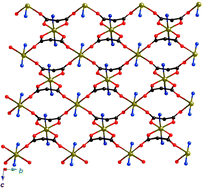Synthesis, crystal structure and magnetic properties of two-dimensional malonato-bridged cobalt(ii) and nickel(ii) compounds
Abstract
Two isostructural malonato-bridged complexes of formula {[M(H2O)2][M(mal)2(H2O)2]}n
[M = Co(II)
(1), Ni(II)
(2); H2mal =


 Please wait while we load your content...
Please wait while we load your content...